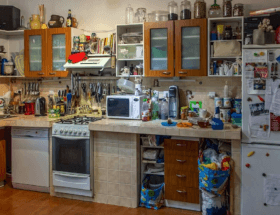Choosing the right flooring material for your bathroom renovation is a decision that balances aesthetics, practicality, and budget. Bathroom floors face unique challenges—constant moisture exposure, temperature fluctuations, and the need for slip resistance.
Among the popular choices, tiles and marble stand out as timeless options, each with distinct characteristics.
This guide will help you understand the fundamental differences between these materials to make an informed decision for your bathroom makeover.
Understanding the Materials
Ceramic and Porcelain Tiles
Tiles used in bathrooms typically fall into two main categories: ceramic and porcelain. Both are made from clay mixtures that are molded and fired at high temperatures, but they differ in composition and manufacturing process.

Porcelain tiles are made from finer, denser clay and fired at higher temperatures (around 2300°F) than ceramic tiles (around 1800°F). This results in a denser, less porous material with greater durability and water resistance—making porcelain particularly suitable for bathroom environments.
Ceramic tiles, while still water-resistant, are more porous than porcelain and often come with a protective glaze that provides the waterproofing necessary for bathroom use. They’re more easily cut and typically less expensive than porcelain.
Natural Marble
Marble is a metamorphic rock formed when limestone is subjected to heat and pressure over millions of years.
This natural process creates the distinctive veining patterns that make each marble slab unique. Marble used for flooring is cut from quarries, polished, and sometimes treated with sealants to enhance its performance in moisture-prone areas.

The main varieties of marble used in bathrooms include Carrara (white with gray veining), Calacatta (white with bold veining), Emperador (brown tones), and Nero Marquina (black with white veining), each bringing a unique character to your space.
Which One To Use?
Durability and Longevity
Tiles: Modern porcelain tiles can last 50+ years with proper installation and maintenance. They resist scratches, chips, and cracks better than many other flooring materials. Ceramic tiles, while still durable, are somewhat more prone to cracking under heavy impact than porcelain.
Marble: Properly maintained marble flooring can last for generations—even centuries, as evidenced by ancient marble floors still intact today including the world famouse Taj Mahal in India and other Mughal era constructions. However, marble is softer than porcelain (3-4 on the Mohs hardness scale compared to porcelain’s 7-8) and more susceptible to scratching, etching from acidic substances, and chipping.
Water and Moisture Resistance
Tiles: Porcelain tiles have a water absorption rate of less than 0.5%, making them essentially waterproof and ideal for wet areas. Ceramic tiles typically have absorption rates of 0.5-3%, which is still considered water-resistant when properly glazed and sealed.
Marble: Natural marble is porous, with absorption rates typically between 0.2-0.6% depending on the variety. This makes it vulnerable to moisture penetration unless properly sealed. Unsealed or improperly sealed marble can absorb moisture, leading to staining and potential bacterial growth. Modern sealants can significantly improve marble’s water resistance, but require regular reapplication every 1-2 years.
Maintenance Requirements
Tiles:
- Daily cleaning with mild soap and water
- Grout lines require periodic cleaning with specialized cleaners
- Minimal to no sealing required for porcelain
- Ceramic may need resealing every 1-2 years depending on traffic
- Resistant to most household chemicals
Marble:
- Daily cleaning with pH-neutral cleaners only
- Immediate wiping of spills, especially acidic substances
- Resealing required every 6-18 months depending on use
- Periodic professional polishing recommended to maintain luster
- Special care needed to avoid etching from acidic cleaners
Temperature Properties
Tiles: Ceramic and porcelain tiles are excellent thermal conductors, meaning they feel cool to the touch—sometimes uncomfortably so in colder months. This property makes them work exceptionally well with underfloor heating systems, as they efficiently transfer heat to the room.

Marble: Marble has similar thermal conductivity to tile, making it cool underfoot but also compatible with underfloor heating. However, marble retains heat slightly better than ceramic tile, potentially feeling less cold on winter mornings.
Slip Resistance
This is a critical consideration for bathroom flooring. Both materials can be slippery when wet, but their safety profiles differ:
Tiles: Many bathroom-specific tiles now come with textured surfaces or anti-slip ratings. The Coefficient of Friction (COF) rating system helps identify suitable options:
- ADA recommends a minimum COF of 0.6 for level floors
- For bathroom use, look for tiles with ratings of 0.7 or higher
- Smaller tiles provide more grout lines, which can increase traction and reduce slip.
Marble: Polished marble has among the lowest slip resistance of flooring materials, with COF ratings often below 0.5. However, alternative finishes can improve safety:
- Honed marble (matte finish): COF typically 0.5-0.6
- Tumbled marble (textured): COF around 0.6-0.7
- Brushed marble: COF approximately 0.6
Both material has the potential to creae slip hazard when necessary precautions are not taken. Make sure the surface is either matt finished or has enough grout lines to create sufficient friction even when wet.
Aesthetic Considerations
Design Versatility
Tiles: Tiles are artificial and manmade so they come in countless colors, patterns, shapes and sizes. They can mimic natural material like wood, stone or even fabric.
Modern digital printing techniques allow photorealistic designs and you can mix and match possibilities for creative layouts.
Marble: On the other hand, marble is a natural substance and each slab has unique natural veining patterns. They are available in limited color palette usually dominated by white, grey, beige and black.
Their natural patterns are associated with timeless elegance and luxury. The offer distinctive character and becomes focal point of the space.
Visual Impact and Property Value
Both materials can enhance your home’s value, but in different ways:
Tiles: High-quality porcelain adds value through practicality and longevity. Designer and artisanal tiles can create unique, personalized spaces that appeal to certain buyers.
Marble: Consistently ranks among the most desirable bathroom materials in real estate listings. The natural stone classification generally commands higher resale premiums than man-made alternatives, though this varies by market.
Installation Complexity
Tiles: Tile installation requires a flat, stable subfloor but offers relative simplicity for the average homeowner. Tiles can be cut and fitted around obstacles with standard tools, making them DIY-friendly for those with moderate experience.
Most bathroom tile projects can be completed in 1-3 days, with fewer specialized skills required compared to natural stone work.
Marble: Marble installation demands exacting standards, beginning with a perfectly level subfloor to support its significant weight. The material requires specialized cutting tools and expertise to handle properly, making professional installation strongly recommended.
Marble’s complexity extends the installation timeline to 2-5 days for an average bathroom, as each piece must be precisely placed and finished by experienced stonemasons.
Cost Analysis
The price difference between these materials is substantial:
Tiles:
- Ceramic: $0.50-$7 per square foot
- Standard porcelain: $3-$10 per square foot
- Designer porcelain: $8-$25+ per square foot
- Installation: $5-$10 per square foot
Marble:
- Standard marble varieties: $10-$20 per square foot
- Premium marble (e.g., Calacatta): $20-$40+ per square foot
- Installation: $10-$20 per square foot
- Additional costs for sealing and special reinforcement
A cost comparison for a standard 50 sq ft bathroom floor:
| Mid-range Porcelain Tile | Standard Marble | |
|---|---|---|
| Material cost | $350 ($7/sq ft) | $750 ($15/sq ft) |
| Installation | $375 ($7.50/sq ft) | $750 ($15/sq ft) |
| Initial sealing | $0 | $150 ($3/sq ft) |
| Initial total | $725 | $1,650 |
| Maintenance (10 yrs) | ~$100 | ~$750 |
| 10-year total cost | $825 | $2,400 |
Environmental Considerations
Ceramic and porcelain tiles involve energy-intensive manufacturing processes, requiring high-temperature kiln firing that consumes significant resources.
However, their environmental profile is improved by increasingly available recycled content options and their exceptional longevity, which reduces the need for replacement over decades of use.
As inert materials, tiles emit virtually no harmful chemicals into your home environment, and choosing locally manufactured options can substantially reduce the carbon footprint associated with transportation.
Marble presents different environmental considerations as a non-renewable natural resource extracted through quarrying, which creates significant landscape disruption and habitat loss.
Its extreme weight results in higher fuel consumption and emissions during transportation from quarry to installation site.
However, marble’s potential lifespan of centuries when properly maintained represents extraordinary material efficiency, and its natural composition ensures zero chemical off-gassing, contributing to healthier indoor air quality throughout its lifetime.
Making the Right Choice for Your Bathroom
Consider these key questions when deciding between tiles and marble:
- Budget: Is your priority initial cost savings or long-term investment?
- Maintenance willingness: How much ongoing care are you prepared to provide?
- Household composition: Do you have young children or elderly family members who might be more vulnerable to slips?
- Design preference: Do you value the unique character of natural stone or the versatility of manufactured tiles?
- Climate: In colder regions, how important is the floor’s feel underfoot, and will you install underfloor heating?
Hybrid Solutions
For those struggling to decide, consider these compromise approaches:
- Marble-look porcelain tiles that replicate the appearance of marble with the practicality of porcelain
- Marble mosaics that use smaller pieces of marble set in a mesh backing, reducing cost while maintaining the natural stone appeal
- Partial marble installations, using marble as an accent in lower-traffic areas while using tile in high-moisture zones
Conclusion
Both tiles and marble offer distinctive advantages for bathroom flooring. Tiles provide practical, low-maintenance, and cost-effective solutions with nearly unlimited design options. Marble delivers unmatched natural beauty and luxury appeal but demands greater care and investment.
Your choice ultimately depends on your personal priorities—whether you value the practical benefits of modern manufactured materials or the timeless elegance of natural stone. With proper selection and installation, either option can create a beautiful bathroom that enhances your daily routine and your home’s value for years to come.

